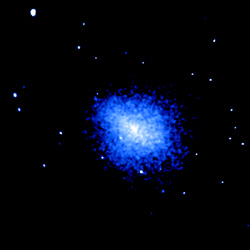September 13, 2002
RELEASE: 02-09
Scientists at the Carnegie Observatories in Pasadena, California, have uncovered six times the expected number of active, supermassive black holes in a single viewing of a cluster of galaxies, a finding that has profound implications for theories as to how old galaxies fuel the growth of their central black holes.
The finding suggests that voracious, central black holes might be as common in old, red galaxies as they are in younger, blue galaxies, a surprise to many astronomers. The team made this discovery with NASA'S Chandra X-ray Observatory. They also used Carnegie's 6.5-meter Walter Baade Telescope at the Las Campanas Observatory in Chile for follow-up optical observations.
"This changes our view of galaxy clusters as the retirement homes for old and quiet black holes," said Dr. Paul Martini, lead author on a paper describing the results that appears in the September 10 issue of The Astrophysical Journal Letters. "The question now is, how do these black holes produce bright X-ray sources, similar to what we see from much younger galaxies?"
Typical of the black hole phenomenon, the cores of these active galaxies are luminous in X-ray radiation. Yet, they are obscured, and thus essentially undetectable in the radio, infrared and optical wavebands.
"X rays can penetrate obscuring gas and dust as easily as they penetrate the soft tissue of the human body to look for broken bones," said co-author Dr. Dan Kelson. "So, with Chandra, we can peer through the dust and we have found that even ancient galaxies with 10-billion-year-old stars can have central black holes still actively pulling in copious amounts of interstellar gas. This activity has simply been hidden from us all this time. This means these galaxies aren't over the hill after all and our theories need to be revised."
Scientists say that supermassive black holes -- having the mass of millions to billions of suns squeezed into a region about the size of our Solar System -- are the engines in the cores of bright active galaxies, often referred to as Active Galactic Nuclei, or AGN. Many astronomers think that all galaxies have central, supermassive black holes, yet only a small percent show activity. What is needed to power the AGN is fuel in the form of a nearby reservoir of gas and dust.
Galaxy clusters contain hundreds to thousands of galaxies. They are the largest known structures in the universe and serve as a microcosm for the mechanics of the Universe at large. The galaxies in clusters are often old, reddish elliptically shaped galaxies, distinct from blue, spiral galaxies like our own. These old galaxies also do not have many young stars.
The theory now in question is that as galaxies enter into clusters at high speeds, they are stripped of their interstellar gas, much as a strong wind strips leaves from a tree. Galaxies may also collide with one another and use up all of their gas in one huge burst of star formation triggered by this interaction. These processes remove most, if not all, of the gas that isn't locked up in stars. As they no longer have the raw material to form new stars, the stellar population slowly gets old and the Galaxy appears red. No gas is left to fuel an AGN.
Previous surveys of galaxy clusters with optical telescopes have found that about only one percent of the galaxies in a cluster have AGN. This latest Chandra observation if typical, however, bumps the count up to about 5 percent. The team found six red galaxies with high X-ray activity during a nearly 14-hour Chandra observation of a galaxy cluster named Abell 2104, over 700 million light years from Earth. Based on previous optical surveys, only one was expected.
"If we relied on optical data alone, we would have missed these hidden monsters," said co-author Dr. John Mulchaey. Only one of the six AGN, in fact, had the optical spectral properties typical of AGN activity.
"The presence of these AGN indicate that supermassive black holes have somehow retained a fuel source, despite the harsh treatment galaxies suffer in clusters, and are now coming out of retirement," said Martini.
This could imply that galaxies are better at holding onto a supply of gas and dust than previously thought, particularly deep down at their cores near the supermassive black hole. This gas and dust may also be the same material that obscures the AGN at other wavelengths.
The presence of so many AGN could also contribute to the radio and infrared radiation from the clusters, which until now was thought to be almost exclusively a product of star formation. Thus, scientists may be overestimating the amount of star formation taking place in clusters.
The Carnegie group has begun a study of other galaxy clusters with Chandra. Martini and Kelson are postdoctoral researchers at the Carnegie Observatories in Pasadena; Mulchaey is a staff astronomer. NASA's Marshall Space Flight Center in Huntsville, Ala., manages the Chandra program, and TRW, Inc., Redondo Beach, Calif., is the prime contractor. The Smithsonian's Chandra X-ray Center controls science and flight operations from Cambridge, Mass.
MEDIA CONTACTS
Steve Roy
Marshall Space Flight Center, Huntsville, AL
Phone: 256-544-6535
Megan Watzke
Chandra X-ray Observatory Center, CfA, Cambridge, MA
Phone: 617-496-7998
cxcpress@cfa.harvard.edu



